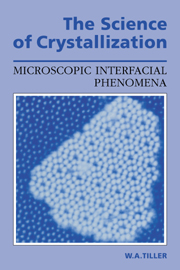Book contents
2 - Interface energetics and molecular attachment kinetics
Published online by Cambridge University Press: 13 February 2010
Summary
This chapter is dedicated to developing the understanding of interface energetics and molecular attachment kinetics and this can be carried out most effectively by considering a completely pure material (all ΔGc effects are eliminated). Both crystal growth by condensation from a pure vapor and crystal growth from a pure melt are suitable vehicles for pedagogical description. However, since the latter has more technological history than the former at the moment (relatively pure Si boules), it will be used as the major example. Since this application utilizes a seed crystal, we will not deal here with the initial stage of nucleation of a crystal. (Nucleation is dealt with in Chapter 8 (Background Science).)
Crystal growth of bulk Si is largely via the CZ technique illustrated in Fig. 2.1. The melt is generally contained in a pure SiO2 crucible and either induction heated via a graphite susceptor (as seen here) or resistance heated via a graphite heater. The crystal is rotated at some angular frequency to produce axial thermal symmetry and forced convection in the melt.
To initiate the crystal, the melt is stabilized at a temperature slightly above the melting point of Si while a rotating seed crystal, held in a chuck, is lowered into intimate physical contact with the melt and a portion of the seed melted back.
- Type
- Chapter
- Information
- The Science of CrystallizationMicroscopic Interfacial Phenomena, pp. 37 - 92Publisher: Cambridge University PressPrint publication year: 1991
- 1
- Cited by



